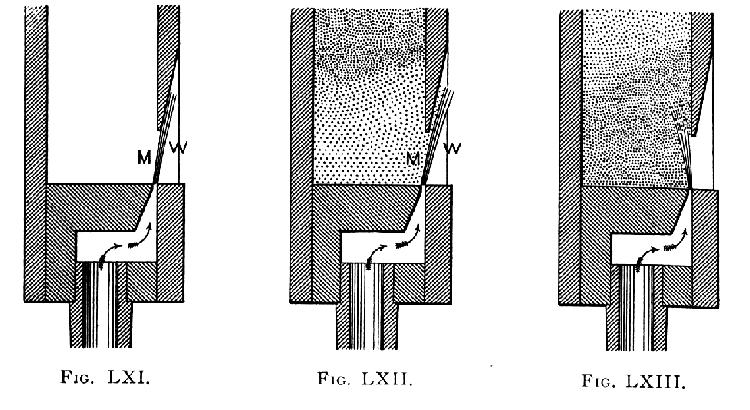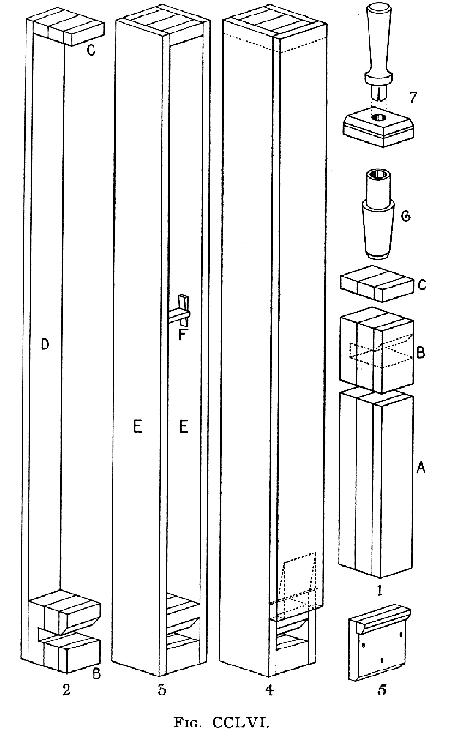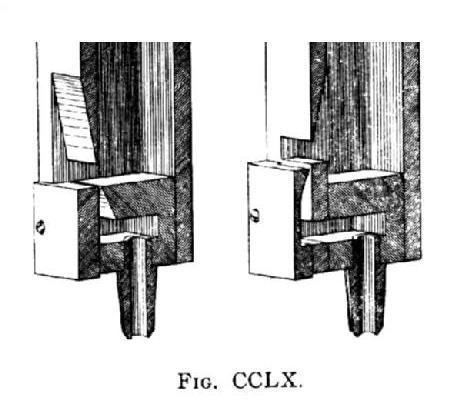
pipe construction illustrations
The following illustrations show one type of organ pipe. Flue, or labial pipes.
How a flue pipe makes
sound:
This wonderful illustration shows exactly how a pipe makes sound. From left to right: Initially, the air in a pipe is at the pressure as air in the surrounding space. When air begins to flow through the mouth, it blows a small stream of wind (W in the diagram) across the opening (called the mouth of the pipe, as indicated by the letter M in diagram LXI.) What happens next, due to the Bernoulli principle, (or was it Venturi? No, it was Bernoulli.) Air inside the pipe gets sucked out along with the air in the stream. This causes a low-pressure condition in the pipe, as shown in LXII. This does not last long, because pressure outside the pipe pushes in through the mouth, and actually pushes the whole wind-stream in the pipe. This does not last long either, as pressure now begins top build inside the pipe. (Fig LXIII) This pressure causes the wind-stream to be pushed out the mouth. and thus we have a cycle. This back-and-forth movement of air is perceived by us as a sound.The astute observer will note that this is nothing more than a whistle. This is something I find amazing. That pipe organs (can) make such lovely music, and actually be nothing more than "a box of whistles". (Actually, this pipe can correctly called a reed pipe, although almost no-one would understand. It is perfectly correct to consider the stream of air a type of reed, and "air-reed".)

This is a diagram of a generic organ pipe of wood construction. This helps to illustrate how a pipe is fashioned. (CCLVI)

CCLX shows two different designs for the mouth of a wood pipe. In either case, the goal is to direct a sheet of moving air across the mouth of the pipe.The shape of the mouth, it's position in the pipe, it's width and height all have a part in the type of tone that a pipe makes.

CCLXIII (left) Shows the mouth of a pipe which produces a tone that is somewhat imitative of a stringed instrument, like a Viol, for example. CCLXIV Shows the same pipe without the "bridge". The bridge helps to form the string-like tone in the pipe. I can imagine the air-stream moving back and forth, "striking" the bridge, and swinging free, almost the same way that a string on a violin strikes the bow, and swings free, the strikes the bow... The sound can be remarkably similar to real stringed instrument, if the pipe was voiced in an artistic manner. In some cases however, it is not desired to have a perfectly imitative sound. In a any organ, it's helpful to have some degree of variety of tones for an organist to choose from, as she plays. So, an organ may have a few different kinds of pipes of a similar type of sound, to suit the variety of types of music it may be expected to render.
<<< Back --- Forward >>>
This page was created November 16, 1997, and is copyright 1997 ARM.